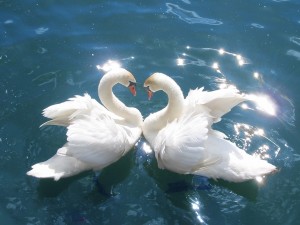
European goddesses often have both an animal and a bird form. Can you guess why Aine’s bird form would be a swan?
Cold and flu season is upon us, and herbalists are writing about garlic, echinacea, mullein, honey, and a host of other beneficial plants. Irish herbalists saw the blessing of the goddess Aine (pronounced ON-ya) as a necessary catalyst in these herbal concoctions. Aine is a fire goddess whose spark makes its circuit throughout the body commencing with every sunrise. Aine often takes the form of a red mare, as in Celtic lore horses are equated with the sun. At Midsummer Aine’s protection for livestock would be invoked by waving torches over animals.Probably due to her fiery nature, Aine appears in stories as a lustful woman with many lovers. She bore many children, and Irish rulers often traced their family lineage to her. She is said to have a stone birthing chair cut into the side of a mountain. Those who sit in this chair become insane, and the insanity is permanent if they repeat this procedure three times. But insanity can also be cured by sitting on Aine’s chair, so perhaps no lapse of sanity is incurable.Like many healing goddesses, Aine has a wrathful side. In one legend she curses her rapist by sucking the skin off his ear and depriving him of his possessions. My guess would be that this is based on an older story related to a broken taboo at Samhain (Halloween). Aine also had a legendary father who was cruel to her. After her escape she became a spinner of sunbeams in the forest (another allusion to her origin as sun goddess) where she tutored wives in the art of slowly debilitating their husbands through herbal interventions. I’m guessing that the debilitated husband story refers to the aging process measured by the movement of the sun, as well as Aine’s role as teacher of herbology.Aine is believed to be the same goddess as Anu, about which little is known aside from her prehistoric monument of twin hills capped with cairns to look like nipples. She has also been equated with Danu, the legendary mother of the Irish gods, which would explain why so many rulers sought to legitimize their reign by claiming to be her descendents.Sources
Celtic Mythology. New Lanark, Scotland: Geddes and Grosset, 1999.
Matthews, Caitlin and John Matthews.
The Encyclopedia of Celtic Wisdom. Shaftesbury, UK: Element Books, 1994.Matthews, John and Caitlin Matthews.
The Encyclopedia of Celtic Myth and Legend. Guilford, CT: Lyons Press, 2004.Monaghan, Patricia.
The Encyclopedia of Celtic Mythology and Folklore. New York: Checkmark Books, 2008.


Now I know why you said she was powerful! Great information!